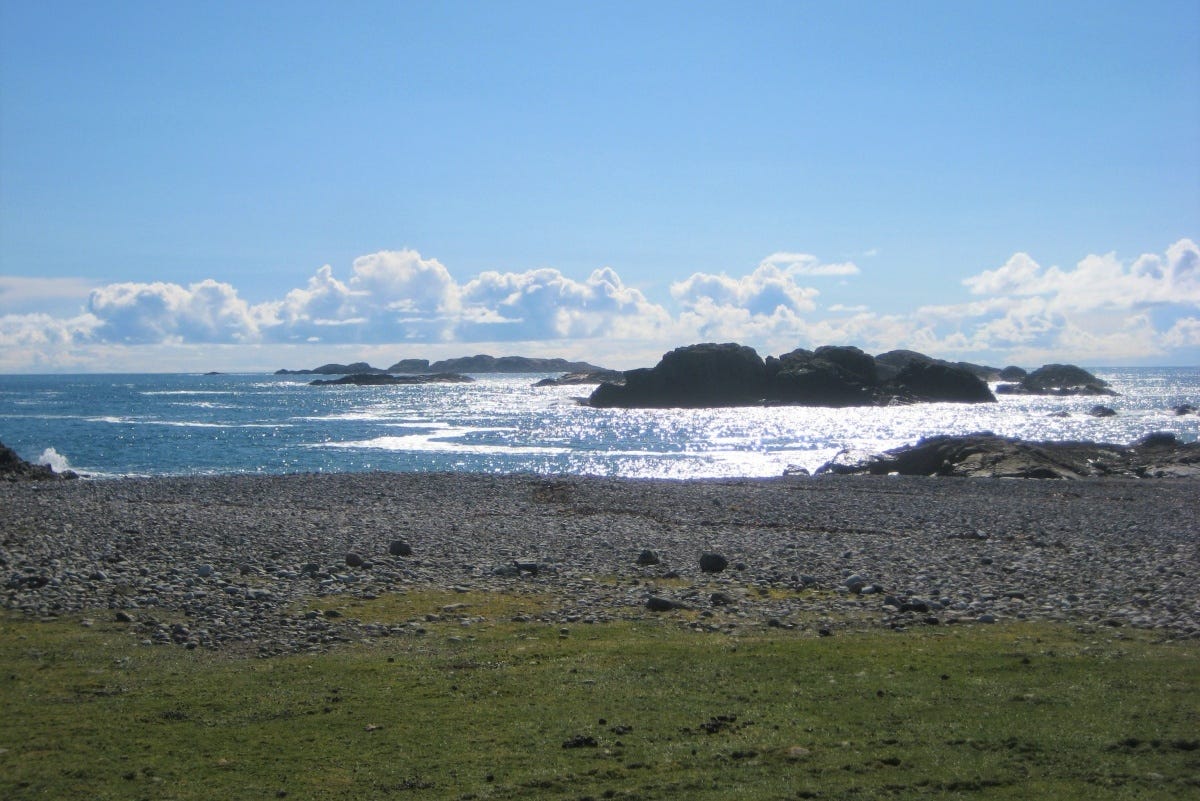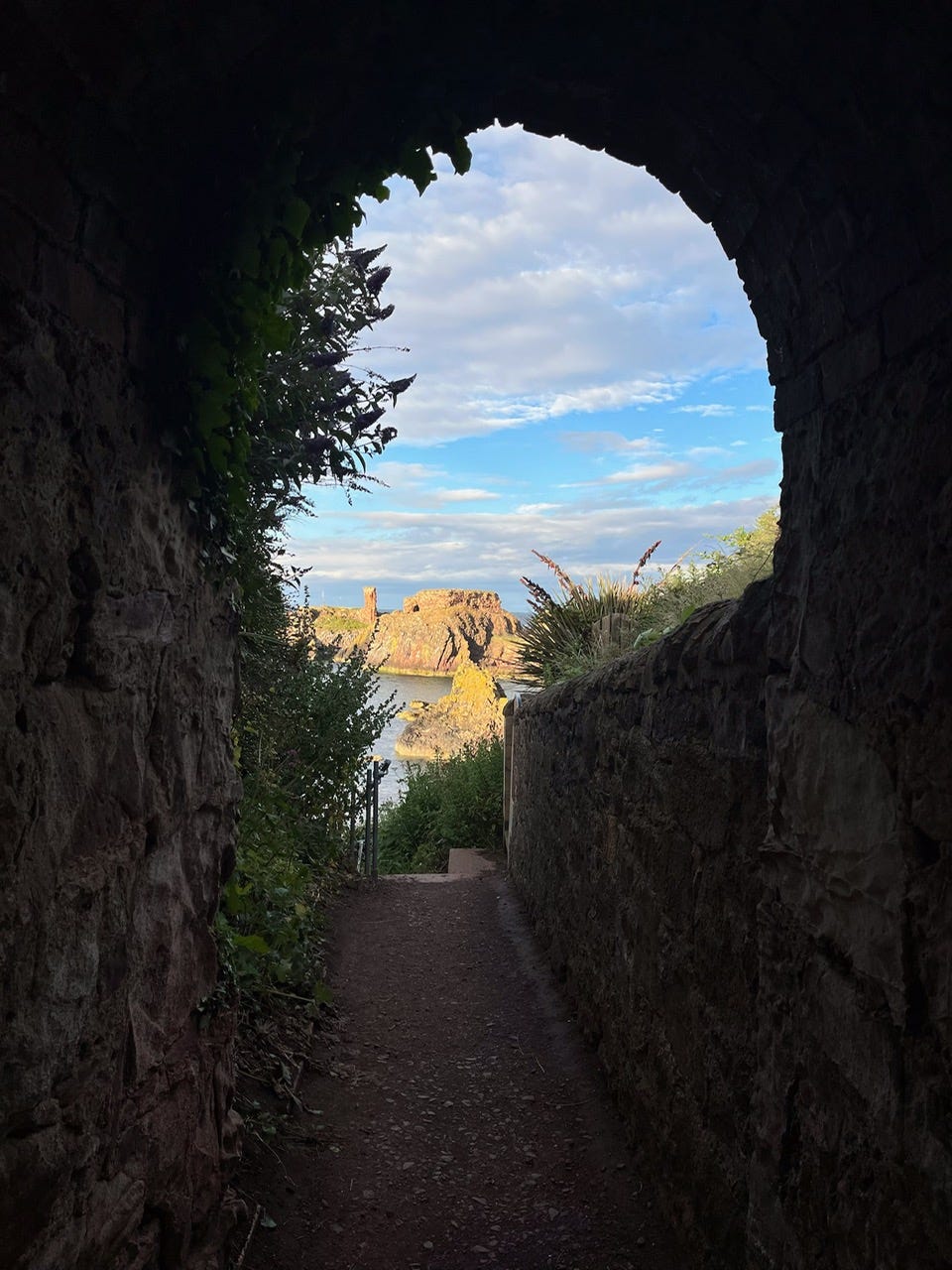Welcome to week three of our Celtic Curriculum for supporting subscribers! This week I’ve decided to open the curriculum to everyone… enjoy, one and all.
Learn more about subscription levels here. Members and friends of Trinity Presbyterian Church in Herndon are eligible for complimentary gift subscriptions; just ask.
I opened iMessage to find a photo of a smiling friend with a resplendent Irish landscape spread out behind him. Hello from the Kerry Way! he told the group of clergy friends. I was lost when I took this photo, but wouldn’t discover it for two more miles. I look pretty happy despite not knowing where I am! We all decided that would definitely “preach.”
And it’s a fitting segue into this week’s curriculum, when we explore the practice of PEREGRINATION. (see also: pilgrimage. wandering. journeying.)
About the Practice
It was the year 563. A monk named Columba received a vision to leave his native Ireland and board a rudderless boat with twelve other brothers and see where the waves and the Spirit would take them. They landed on a remote island off the west coast of Scotland, which would come to be known as Iona. Iona is the place where Christianity touched Scotland for the first time, and remains a vibrant site of Celtic spirituality and Christian hospitality to this day.
One of the beautiful features of a stay on Iona is the chance to take part in the pilgrimage, a multi-hour hike around the island. Guides lead the way from holy site to holy site, offering readings, blessings, and silence. A highlight of the pilgrimage is a visit to the beach where Columba’s boat is said to have arrived. Most of Iona’s residents live on the east side of the island, with the island of Mull in plain view. St. Columba’s Bay is on the west side of the island. It’s hard to overstate how remote it feels, how vast the sea is beyond the rocky outcroppings of the bay. Those monks somehow survived the journey and landed there, but to borrow from a poem by Jane Kenyon, it might have been otherwise.
There’s a tension in this week’s practice. The trek around Iona is a pilgrimage. So is the Camino de Santiago, the Kerry Way that my friend is traveling, or the Jesus Trail in the Galilee region of Israel (on my bucket list). These journeys take place on well-established paths, and while there may be surprises and transformations, you more or less know what you’re getting into. What Columba did? That’s peregrination: a setting out without a path in mind, a sacred wandering, a wholehearted surrender to God/the Universe/the Great Whatever. Celtic teacher Dara Molloy calls peregrination “a destiny rather than a destination.”
If pilgrimage is different from peregrination, vacations are even more so, at least as many of us engage with them. Some of us plant ourselves at the same beautiful site every year, erecting a beach umbrella and sitting with a book, or playing in a lake’s cool waters, or gazing at a familiar mountain vista. Others of us visit exciting new locations with a guidebook tucked in our bag, a list of recommendations from friends, and our smartphones loaded up with audio tours.
It’s understandable–life foists peregrinations upon us all the time, through health challenges, job changes, the ending of relationships, the death of loved ones. It’s natural to find refuge in familiar vacation spots, or a well curated and perfectly optimized sightseeing trip. But as John Philip Newell reminds us, peregrination for the Celts was about seeking one’s “place of resurrection, setting sail into the unknown in search of new beginnings… a sacred journey that opens to us from the heart of life in every moment.” Such a journey takes great intentionality—not in the sense of planning, but in the sense of listening, moment by moment, for the next right step.
Lord of the Rings fans will recognize the word peregrination. The impish hobbit Pippin’s full name is Peregrin Took. It’s notable that Pippin was the youngest of the Fellowship to set out on that long trek to destroy the Ring of Power; he was not even of age. This is the spirit of peregrination, unfolding over three books (or three lengthy but near-perfect movies, depending on how you consume the tale). Peregrinations rely not on our own competence, but on confidence in the One who will be with us every unexpected step.
“The Christian scriptures speak of a ‘way,’ but it is not the path of expectations,” writes Christine Valters Paintner. “It is not the ten-step plan for inner peace. Instead, this way calls us to a deeper and more radical trust that the way is made by walking. Each step is shaped by listening to how the divine presence calls us forward, the direction we take, the choices we make, and how much control we’re willing to yield.”
Personal Reflection
“Will you go for the funeral?” my mom asked me the other day. The 100-year old matriarch in Robert’s family has been in decline for some time, and her hospice nurses believe she’s in her last few weeks. We’ve been receiving regular updates from our family in the Twin Cities, where Mama Ruth lives in a nursing home.
“I have no idea,” I responded. “I only know what I’m doing today.” Many of you know that our family is in a tough season and has been for some time. For whatever reason, adolescence hits the Dana kids extremely hard psychologically, and these days are demanding a lot of us as parents. I want more than anything to be there to celebrate the life of this incredible person, whenever that happens, but I can’t predict what will be best for everyone involved, or even possible.
I know we’re in a peregrination, a sojourn off the familiar paths. We’re seeking resurrection, and believe it’s out there for our family, but we don’t know how or when it will emerge. Peregrination can be frustrating: why can’t I see where this is headed? But when I said, “I have no idea, I only know what I’m doing today,” I felt nothing but freedom: I know what’s mine to do for this moment.
This is the freedom we experienced last summer on the John Muir Way, a pilgrimage with elements of peregrination woven into it. To be clear, we knew how many miles we were to travel each day (between 10 and 15) and where we would end up (a variety of inns and B&Bs, with our luggage waiting for us in a comfy room). But there were lots of unknowns: weather, boredom, aches and pains. We saw some incredible views along the way, but the sight I grew to love the most was this:
These are the waymarkers that dotted the entire 134-mile route. It was unbelievably liberating to walk out our front door each morning, find the nearest marker, and simply follow where the arrows pointed until we were done that day. Like my friend on the Kerry Way, we got lost a few times, but for the most part, a waymarker would crop up exactly when we needed it most.
I can’t say for certain that last year’s journey gave me the tools to navigate this year’s family pilgrimage, but I think it did. At my best, each morning I try to ask, What does love require of me today? and use that question as a waymarker. Sometimes love requires planning ahead, of course—wrestling with insurance companies, tracking medication, making appointments—but other times it’s a steadfast listening: to our bodies, our immediate needs, our yearning for joy or connection.
I heard recently that the word “wandering” has its roots in words that mean a day’s travel, or a day’s work. I’m comforted by the idea that even the most harrowing peregrinations happen one modest portion at a time. As Carrie Newcomer sang almost three decades ago:
When I was a child I still thought like a child
And I still feel like a child sometimes
But I’m learning the farthest I will travel each day
Is to the edge of my vision, then a little more ways.
Make The Practice Yours
What waymarkers do you follow in your own life? How are those markers currently serving you, or not? Are there new waymarkers you might find?
The desert father Abba Poemen said, “Do not give your heart to that which does not satisfy your heart.” Live this teaching for a week, or just a day, and see what you discover.
How can this summer be a time of peregrination, or at least pilgrimage? Consider reframing a vacation or other travel using this more intentional language of peregrination/pilgrimage, and notice if anything shifts when you do.
My favorite site on Iona is the Augustinian nunnery, now in beautiful ruins, open to the sky, with flowers sprouting from the ancient rocks. I have a photo of it on my desk to connect me with that place. Where is your place? Consider putting a photo of it somewhere special so you can travel there without even leaving your home.
Discuss
In comments, share some of the peregrinations or pilgrimages you’ve undertaken, either voluntarily or involuntarily. What did you learn? Let’s share encouragement with one another.
Closing Meditation
This is the blessing Robert and I shared as we started our pilgrimage in Scotland last year:
God bless the path on which you go
God bless the earth beneath your feet
God bless your destination.
God be a smooth way before you
A guiding star above you
A keen eye behind you
This day, this night, and forever.
God be with you whatever you pass
Jesus be with you whatever you climb
Spirit be with you wherever you stay.
God be with you at each stop and each sea
At each lying down and each rising up
In the trough of the waves, on the crest of the billows.
Each step of the journey you take.
Sources:
The Soul’s Slow Ripening: 12 Celtic Practices for Seeking the Sacred, Christine Valters Paintner
“Otherwise,” Jane Kenyon
The Rebirthing of God: Christianity’s Struggle for New Beginnings, John Philip Newell—a lovely meditation on Celtic Christianity, using the sites of the Iona pilgrimage as a frame for the book. Recommended if you wish to pilgrimage in place.
Christ of the Celts: The Healing of Creation, John Philip Newell
“Closer to Home,” Carrie Newcomer from the album The Bird or the Wing. I made a small substitution from “blindness” to “vision” to be a bit more inclusive, and trust she would approve the spirit of the change.
Celtic Blessings, Prayers for Everyday Life, Ray Simpson









Your suggestion to think about what my way marks are and if I might need new ones caused me to think about how I start my days and whether that was a satisfying way to set the tone. I think I’m going to try starting with meditation and journaling rather than the crossword puzzle.
Thank you for the Celtic spirituality focus!
Thank you, I needed those words tonight. It brings to mind the wonderful John Muir quote in which he says he hates the word "hike", because what we out to do is "saunter". I don't have access to the exact quote, but he gives a derivation of saunter, saying it's rooted in the French name for pilgrims en route to the Holy Land. He says we are to saunter, to walk with reverence through creation.